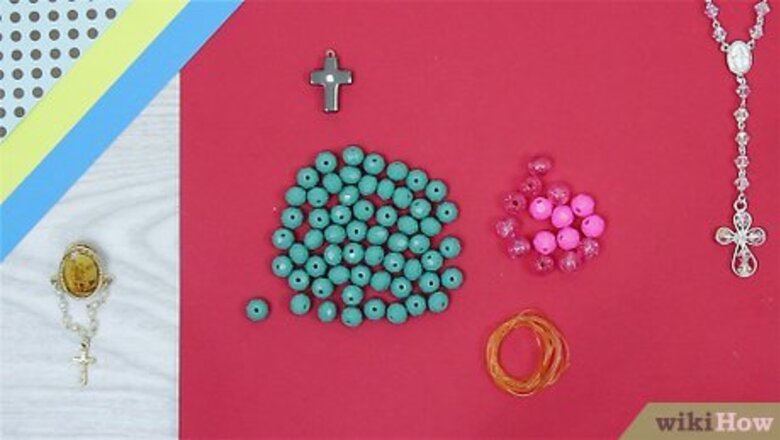
views
Making a Rosary with Cord
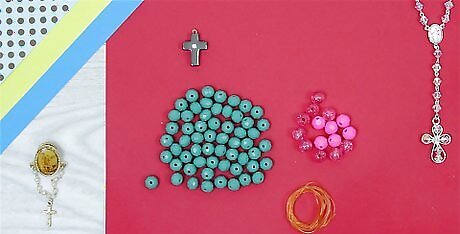
Gather your supplies. A rosary is composed of a crucifix, 53 beads of one color to represent Hail Mary prayers, and 6 beads of another color to represent Our Father prayers. The crucifix and beads are strung in a pattern on sturdy string or thread or a chain. Religious supply stores sell small crucifixes suitable for making rosaries. They also commonly sell beads to represent the Hail Mary and Our Father prayers. Waxed nylon cord is commonly used for making rosaries. Be sure to pick a cord that fits through the centers of the beads you’ve chosen. The beads should fit easily, but they shouldn’t be loose.
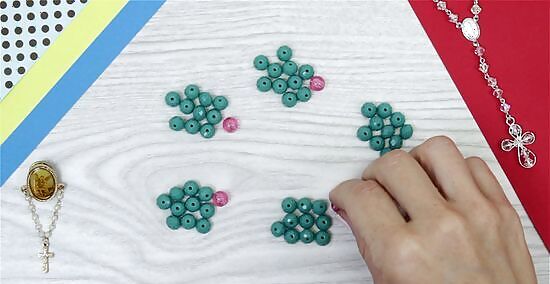
Sort the beads. Rosaries are divided into 5 “decades,” or sections, that contain 10 beads each, as well as a smaller section with 3 more beads. Divide the Hail Mary beads into 5 groups of 10 and one group of 3. Place the Our Father beads in a separate pile.
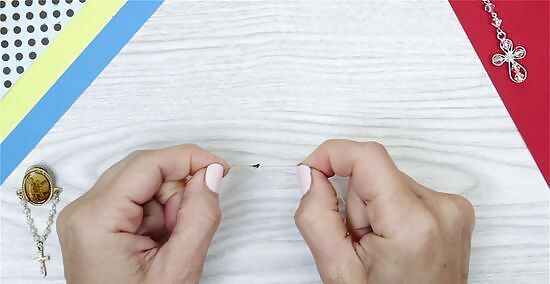
Knot the end of your cord. You’ll need about 3 feet (1 meter) of cord. Use a ruler and a pen to mark a dot about 6 inches (15.2 cm) from the end, then tie a knot over the dot to begin the rosary. The knot should be large enough to prevent the beads from slipping over it onto the other side of the cord.
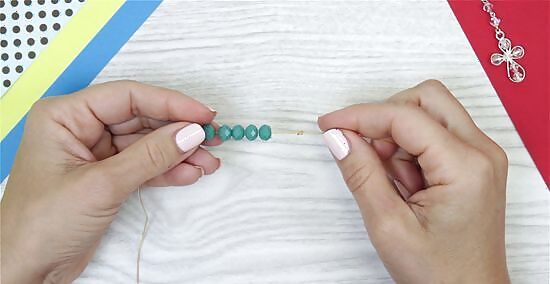
String 10 Hail Mary beads on the long end of the cord. Make sure they stack up on the long end of the knot and that there’s no chance they’ll be able to slip over to the other side. Tie a second knot at the end of the string of beads. Leave a little space for the beads to slide, but not too much. When using the rosary, you should be able to slide the beads down slightly once each prayer is complete. If you’re struggling to tie the knot in a certain place, make a loose knot over the place you want to tighten it. Place a toothpick on the cord in the spot where the knot should go, then pull it tight and remove the toothpick.
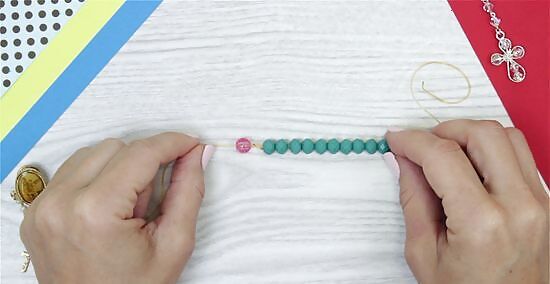
String an Our Father bead after the second knot. This bead should be a different color from the 10 Hail Mary beads you have already strung. Tie another knot directly after the Our Father bead.
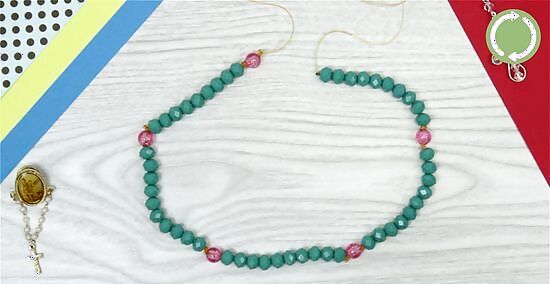
Repeat the process with the other 4 decades. After tying a knot after the first Our Father bead, string 10 more Hail Mary beads. Then, tie a knot, string an Our Father bead, and tie another knot. Continue until you’ve strung all 5 decades with the exception of the final Our Father bead. Finish with a knot after the last set of 10 Hail Mary beads.
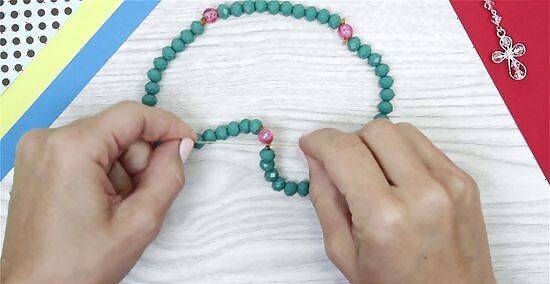
Tie the ends together. Form a circle of beads by tying the 2 ends together after the first and last knot. You should have a circle of 5 decades with 2 string tails hanging loose. If your beads are large enough to slip over both tails, you may keep both strings intact. If your beads are too small to slip over both tails, trim the shorter tail with a pair of scissors. Use a dab of clear nail polish or glue to keep the last knot secure as you continue.
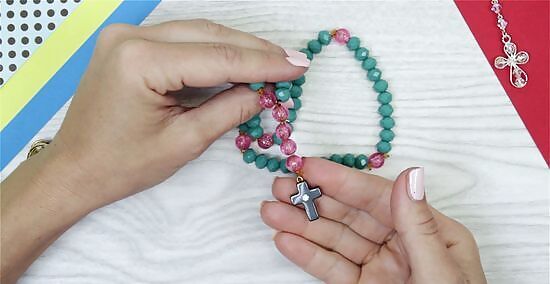
String the final beads and crucifix. String the last Our Father bead and tie a knot directly after it. Then, string the last 3 Hail Mary beads and tie another knot to keep them in place. Add the crucifix and secure it tightly by adding a double knot after you’ve strung it on the rosary. Use more clear nail polish or adhesive to keep it in place and clip the loose thread hanging off the knot.
Making a Chain Rosary
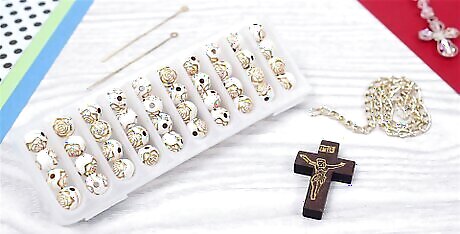
Gather your beads and chain. Rosaries are made with 53 Hail Mary beads of a single color, 6 Our Father beads of another color, and a crucifix. You’ll also need one 8-inch (20.32 cm) chain or fourteen 3-link pieces to string the beads together. If you don’t have much experience with making jewelry or working with wire cutters, making a rosary with a cord might be the easier method. Find crucifixes and rosary beads at your local religious supply store.
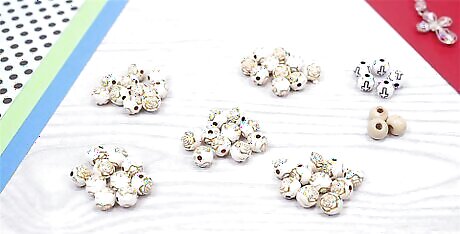
Separate the beads into decades. Standard rosaries are divided into 5 “decades,” or sections, that contain 10 beads each, plus a smaller section of 3 beads. Sort the Hail Mary beads into 5 groups of 10 and one group of 3, and separate the Our Father beads into their own pile.
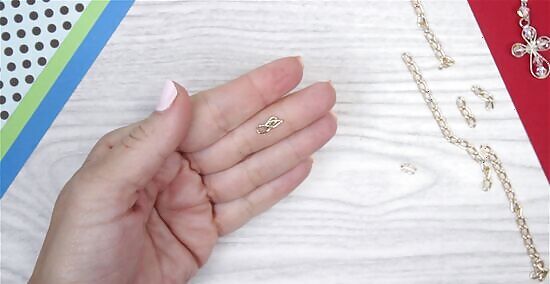
Cut the chain, if necessary. If you’re using a single piece of chain, use wire cutters to cut every 4th link, creating 14 pieces with 3 links each. To keep the pieces from flying everywhere, hold the chain down in between the cutters and close the jaws so they hold the 4th link. Cover the area with your hand when you apply pressure.
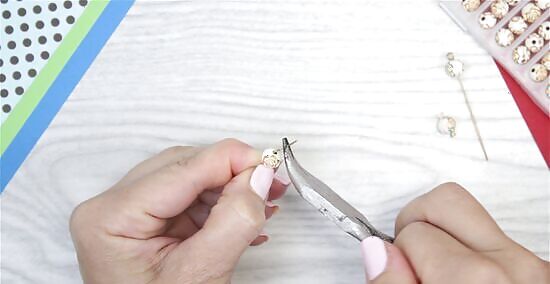
Mount each bead onto an eye pin. Eye pins have one looped end and one straight end. Place each bead onto a separate pin so it’s flush with the loop, then bend the straight end 90 degrees toward the bead so that it’s perpendicular to the loop. Use round nose pliers to grasp the end of the pin and roll it toward the bead to create a second loop. Be careful not to use too much pressure, especially if you’re using glass beads, so you don’t chip the beads. Repeat this process for all 59 beads.
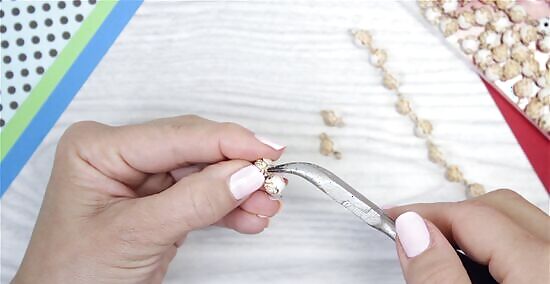
String the Hail Mary beads of each decade together. Connect each set of 10 by twisting one loop of each bead’s eye pin open with your pliers. Do not unroll the loop. Place the loop of the next bead on the open loop and twist it closed. Use the same technique to connect the set of 3 beads. When stringing together the entire rosary, you’ll first string one Hail Mary decade, then a single Our Father bead, then another Hail Mary. Repeat this pattern for all 5 decades. The remaining 3 Hail Mary and 2 Our Father beads will hang below and attach to the crucifix.
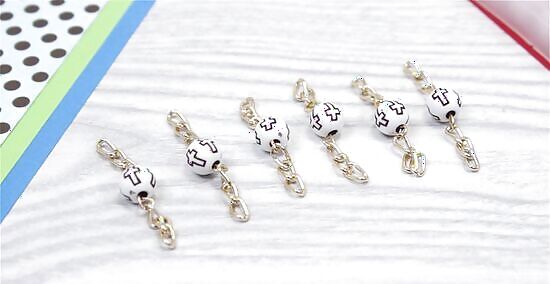
Connect a piece of the chain to each Our Father bead. Use the same process from the previous step to open each loop of the 6 Our Father beads and connect a piece of the chain to each loop.
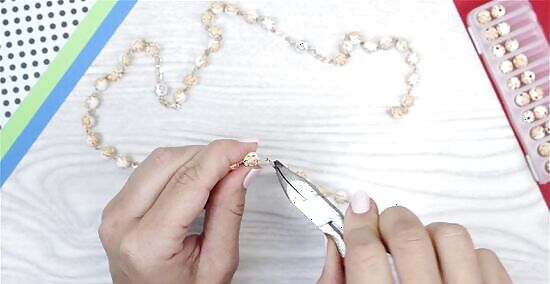
Attach the bead sections to form the rosary. Using the same twisting method, attach a chain piece to the end of the first decade. Connect the chain from one end of an Our Father section to the other end of the first decade. Attach the other end of the Our Father to another decade. Continue these steps until all decades have been strung together, separated by 4 Our Fathers.
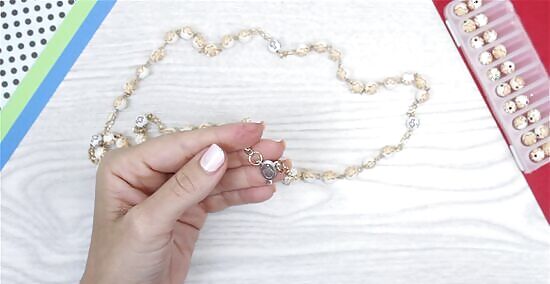
Connect the decades to the center. A rosary center is a 3-way connector that the crucifix will hang from. Add the last piece of chain to the end of the last decade. Then, twist open a jump ring and use it to connect one end of the decade chain to one of the center’s top loops. Repeat with the other end of the decade chain.
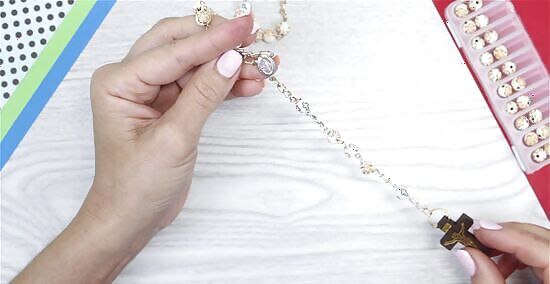
Attach the 5 remaining beads and the crucifix. Keep using the same method to connect the last 2 Our Father beads to the 3 Hail Marys. Then, open another jump ring and connect this string of beads to the bottom loop of the center. Open the crucifix’s jump ring and connect it to the other end of the beads. Align the loops of the Our Father above the crucifix so that they face the same direction. This allows the crucifix and the center to face the same way. After connecting everything, go through all the loops to make sure they’re tight.
Making a Single-Decade Rosary
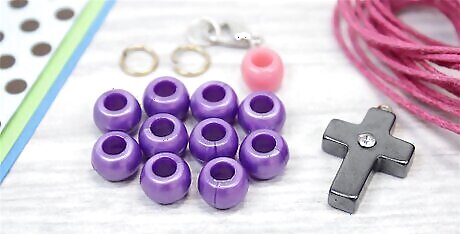
Gather your supplies. A single-decade rosary, or sacrifice beads, consists of 10 Hail Mary beads and 1 Our Father bead. These can all be the same color, or you can choose a separate color for the Our Father. You’ll also need string, 2 additional spacer beads, a crucifix, and a saint medallion. You should be able to find the crucifix, medallion, and prayer beads at your local religious supply store.
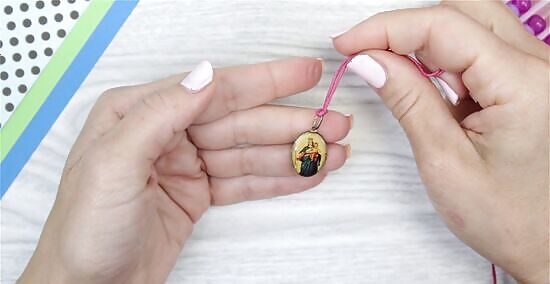
Cut the string and thread the medallion. Cut a 3-foot (91.44 cm) length of string and fold it in half. Insert the looped end through the hole of the medallion from front to back, then put the 2 cut ends through the loop. Pull tightly to create a knot.
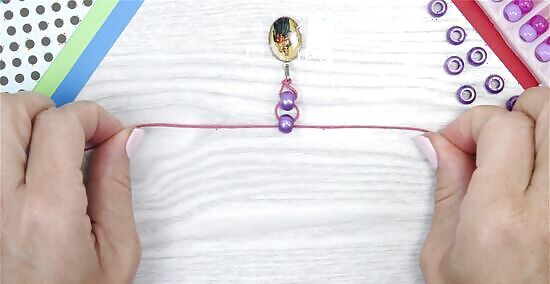
Thread the Hail Mary beads. Keep each end of the thread separate and slide a bead onto the left thread. Then, insert the right thread through the bead, but in the opposite way so that the ends of the string form an X inside the bead. Pull the threads in opposite directions to tighten and slide the bead down to the medallion. Repeat the process for the other 9 Hail Mary beads. Adjust each bead individually so they lay horizontally and ensure the thread is tight. Trim the ends of the threads so they’re even.
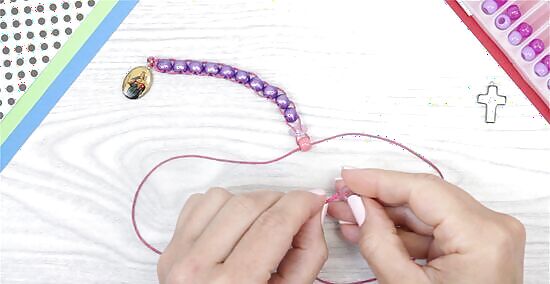
Attach the Our Father bead. After placing the last Hail Mary bead, hold both ends of the string together and run them through a spacer bead. Add the Our Father bead the same way and follow up with the second spacer bead.
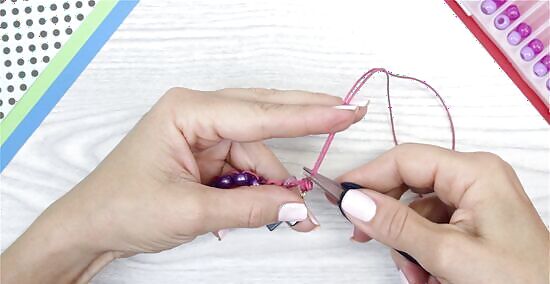
Tie on the crucifix. Hold both ends of the string together and thread them through the hole at the top of the crucifix. Pull the crucifix up toward the spacer bead, and hold your finger along the spacer bead and the top of the crucifix. Loop the threads around your finger and insert the ends of the threads through the loop to form a knot. Tie a second knot the same way and pull to tighten. Use pliers to tighten the knots, then use scissors to trim the thread as close to the knot as possible.
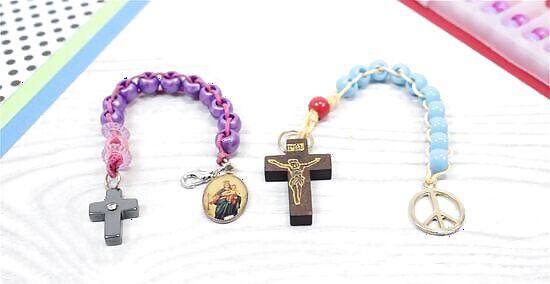
Attach a jump ring and clasp to the medallion. Use pliers to twist the jump ring open and insert the lobster claw clasp onto it. Then thread the open jump ring onto the opening at the top of your medallion and pinch it closed with the pliers. If your medallion only has the hole you threaded the string through, you can attach the clasp there as well.




















Comments
0 comment